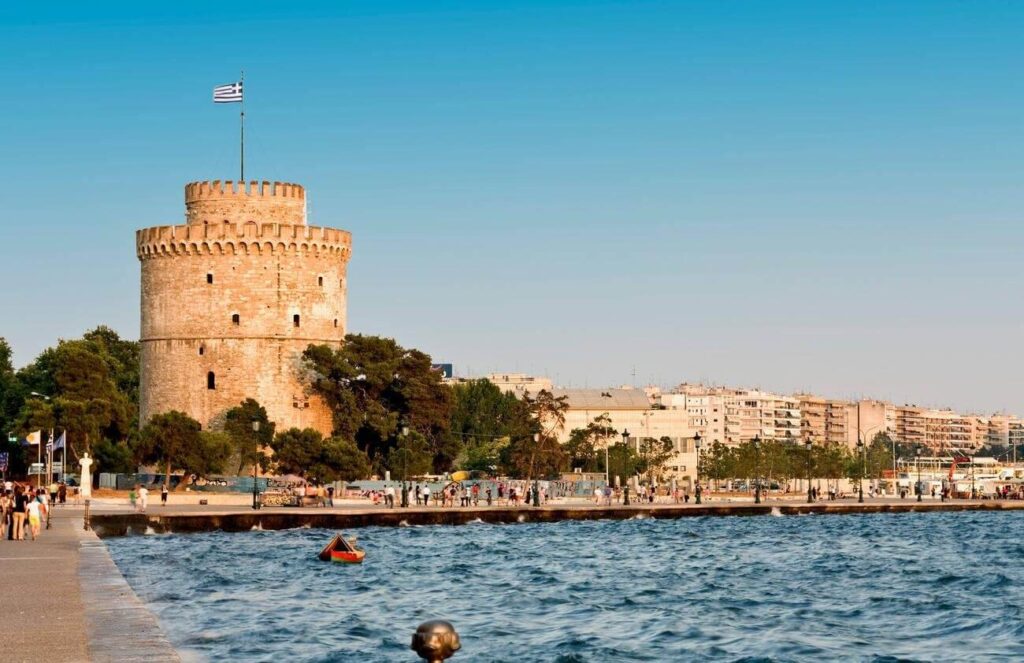Thessaloniki and Athens are two of the most popular destinations in Greece. They offer a rich cultural heritage, lively nightlife, and a variety of attractions. Travelling from Thessaloniki to Athens is easy and convenient, as there are several options.
Renting a car is convenient for travelling from Thessaloniki to Athens, Greece’s two largest cities. The distance between Thessaloniki and Athens is 515 kilometers (320 miles), and the drive takes 5 hours via the A1/E75 highway. The average cost to rent a car for a one-way trip from Thessaloniki to Athens is €50 ($54.5, £43.5) to €100 ($109, £87). When renting, important factors to consider are car size, transmission type, mileage limits, and any additional insurance options. Compact cars with manual transmission tend to offer the best value. Flying is the fastest way to travel between Thessaloniki and Athens, Greece’s two largest cities, 515 kilometers (320 miles) apart. Regular nonstop flights between Thessaloniki International Airport and Athens International Airport take 45 minutes. The average cost of a one-way plane ticket from Thessaloniki to Athens is €50 ($54.5, £43.5) to €100 ($109, £87). Airlines like Aegean Airlines, Ryanair, and Sky Express operate frequent daily flights on the route. Ticket prices fluctuate based on date, time of day, and demand.
Bus travel is a common public transportation option for the 515-kilometer (320-mile) journey between Thessaloniki and Athens. Direct bus trips take 5 to 6 hours to complete and have an average cost of €30 ($32.7, £26.1) to €50 ($54.5, £43.5) one-way. Major bus companies like KTEL operate frequent daily routes between the two cities. Tickets can be purchased at stations in each city. The bus fare is cheaper than driving, flying, or taking the train. Hiring a taxi for a one-way transfer between Thessaloniki and Athens covers the 515-kilometre (320-mile) journey in 5 hours, and expect to pay €300 ($327, £261) to €400 ($436, £348) for a private taxi to drive this intercity route. Prices vary between providers and depend on additional fees. The main advantage of a taxi is the door-to-door service and flexibility over bus or train schedules. Travellers do not have to change transport, but the high cost makes it an expensive option for solo travellers or groups smaller than four people.
What is Thessaloniki?
Thessaloniki is the second-largest city in Greece and the capital of the region of Macedonia. It has over 1 million people and a history of over 2,300 years. It is located on the Thermaic Gulf, at the northwest corner of the Aegean Sea. Thessaloniki is a cultural and economic hub, hosting many festivals, events, and exhibitions. It is also a major transportation centre for Greece and southeastern Europe, with a busy port and an international airport. It has a rich and diverse heritage, influenced by various civilisations, such as the Romans, Byzantines, Ottomans, and Jews.
Thessaloniki has a Mediterranean climate, with hot and dry summers and mild and rainy winters. The average temperature in July is 26 ℃ (79 ℉), and in January is 9 ℃ (48 ℉). The city is surrounded by hills and mountains, such as Mount Olympus, the highest peak in Greece. The city also has many beaches and resorts along the coast, attracting tourists and locals alike. Thessaloniki has many attractions and landmarks, both ancient and modern. Some of the most famous ones are the White Tower, a symbol of the city and a former prison; the Arch of Galerius, a Roman monument commemorating the victory over the Persians; the Rotunda, a circular building that was once a temple, a church, and a mosque; the Hagia Sophia, a Byzantine church modelled after the one in Constantinople; and the Museum of Byzantine Culture, which displays artefacts and artworks from the Byzantine era.
Thessaloniki is at the coordinates 40°38′25″N 22°56′05″E. It covers an area of 19.307 square kilometers (7.454 square miles) in its municipality and 1285.61 square kilometers (496.38 square miles) in its metropolitan area. The city is well-connected by road, rail, sea, and air and has a busy port and an international airport.
How to get from Thessaloniki to Athens?
To get from Thessaloniki to Athens, one can consider renting a car, taking a plane ride, opting for a bus journey, or arranging a taxi transfer. Thessaloniki and Athens are two of Greece’s largest and most important cities, with a rich history, culture, and attractions. There are several ways to travel between them, depending on the traveller’s budget, time, and preferences.
Listed below are the ways to get from Thessaloniki to Kavala:
- Car Rental: Renting a car is convenient for travelling from Thessaloniki to Athens, Greece’s two largest cities. The distance between Thessaloniki and Athens is 515 kilometres (320 miles), and the drive takes 5 hours via the A1/E75 highway. The average cost to rent a car for a one-way trip from Thessaloniki to Athens is €50 ($54.5, £43.5) to €100 ($109, £87). When renting, important factors to consider are car size, transmission type, mileage limits, and any additional insurance options. Thessaloniki car rentals with manual transmission tend to offer the best value.
- Plane Ride: Flying is the fastest way to travel between Thessaloniki and Athens, Greece’s two largest cities, 515 kilometers (320 miles) apart. Regular nonstop flights between Thessaloniki International Airport and Athens International Airport take 45 minutes. The average cost of a one-way plane ticket from Thessaloniki to Athens is €50 ($54.5, £43.5) to €100 ($109, £87). Airlines like Aegean Airlines, Ryanair, and Sky Express operate frequent daily flights on the route. Ticket prices fluctuate based on date, time of day, and demand.
- Bus Ride: Bus travel is a common public transportation option for the 515-kilometer (320-mile) journey between Thessaloniki and Athens. Direct bus trips take 5 to 6 hours to complete and have an average cost of €30 ($32.7, £26.1) to €50 ($54.5, £43.5) one-way. Major bus companies like KTEL operate frequent daily routes between the two cities. Tickets can be purchased at stations in each city. The bus fare is cheaper than driving, flying, or taking the train.
- Taxi Transfer: Hiring a taxi for a one-way transfer between Thessaloniki and Athens covers the 515-kilometre (320-mile) journey in 5 hours, and expect to pay €300 ($327, £261) to €400 ($436, £348) for a private taxi to drive this intercity route. Prices vary between providers and depend on additional fees. The main advantage of a taxi is the door-to-door service and flexibility over bus or train schedules. Travellers do not have to change transport, but the high cost makes it an expensive option for solo travellers or groups smaller than four people.

1. Car Rental
Renting a car is convenient for travelling from Thessaloniki to Athens, Greece’s two largest cities. The distance between Thessaloniki and Athens is 515 kilometers (320 miles), and the drive takes 5 hours via the A1/E75 highway. The average cost to rent a car for a one-way trip from Thessaloniki to Athens is €50 ($54.5, £43.5) to €100 ($109, £87). When renting, important factors to consider are car size, transmission type, mileage limits, and any additional insurance options. Compact cars with manual transmission tend to offer the best value.
Renting a car provides flexibility and freedom not offered by other modes of transportation between the cities. Drivers can travel on their schedule, take side trips, and have a vehicle while exploring Athens. The scenic route also allows travellers to stop at historic towns like Lamia and Thebes; however, fuel, tolls, parking, and dealing with big city traffic in Athens are expensive. Driving in Greece can also be challenging with winding mountain roads. Hiring a car also means not being able to relax and enjoy the scenery as travelling by bus or train.
The most direct route from Thessaloniki to Athens by car is to take the A1 south through the regions of Macedonia and Central Greece, passing by the cities of Lamia and Thebes before arriving in Athens. Drivers should plan for traffic getting in and out of both cities and allow extra time to account for stops or getting lost.
2. Plane Ride
Flying is the fastest way to travel between Thessaloniki and Athens, Greece’s two largest cities, 515 kilometers (320 miles) apart. Regular nonstop flights between Thessaloniki International Airport and Athens International Airport take 45 minutes. The average cost of a one-way plane ticket from Thessaloniki to Athens is €50 ($54.5, £43.5) to €100 ($109, £87). Airlines like Aegean Airlines, Ryanair, and Sky Express operate frequent daily flights on the route. Ticket prices fluctuate based on date, time of day, and demand.
Flying eliminates the 5-hour drive and provides much quicker access between the cities. Air travel is convenient for business trips or when time is limited, but flights do not allow travellers to stop at historic towns like Lamia and Thebes. Airport transfers, baggage fees, and processing time should also be considered. The plane journey is very direct. After taking off from Thessaloniki, the flight path crosses over Central Greece before descending into Athens from the east. This aerial route bypasses the winding mountain roads and heavy traffic that drivers must contend with on the A1 highway.
3. Bus Ride
Bus travel is a common public transportation option for the 515-kilometer (320-mile) journey between Thessaloniki and Athens. Direct bus trips take 5 to 6 hours to complete and have an average cost of €30 ($32.7, £26.1) to €50 ($54.5, £43.5) one-way. Major bus companies like KTEL operate frequent daily routes between the two cities. Tickets can be purchased at stations in each city. The bus fare is cheaper than driving, flying, or taking the train.
Riding the bus allows travellers to relax and enjoy views of the Greek countryside. Stops are made in towns like Larissa and Lamia for rest breaks. Travel time might take longer than flying, and travellers lack the flexibility to control schedules or make side trips. The intercity buses trace the E75 national highway from Thessaloniki south through Central Greece before arriving in Athens from the north. Along this overland route, passengers can see rural villages, farmland, and mountains that car or aeroplane passengers miss.
4. Taxi Transfer
Hiring a taxi for a one-way transfer between Thessaloniki and Athens covers the 515-kilometre (320-mile) journey in 5 hours, and expect to pay €300 ($327, £261) to €400 ($436, £348) for a private taxi to drive this intercity route. Prices vary between providers and depend on additional fees. The main advantage of a taxi is the door-to-door service and flexibility over bus or train schedules. Travellers do not have to change transport, but the high cost makes it an expensive option for solo travellers or groups smaller than four people.
Thessaloniki taxis allow customisation of routes and the option to stop for breaks or sightseeing; however, there is a lack of cost savings and the inability to get up and move around during the long drive. Comfort levels depend on the vehicle size and driver quality. The taxi follows the most direct route, taking the E75/A1 national highway south from Thessaloniki before entering the Athens metropolitan area from the north. The complete journey passes through the regions of Macedonia and Central Greece on the way.
What is the best way to get from Thessaloniki to Athens?
The best way to get from Thessaloniki to Athens is by plane. Firstly, this option offers the fastest travel time. Flights between the two cities typically take 45 minutes, allowing travellers to reach their destination quickly and enjoy the best beaches in Thessaloniki. Secondly, flying provides convenience and comfort. Thessaloniki International Airport, or Macedonia Airport, offers regular flights to Athens throughout the day, providing travellers with various departure options. The airport has modern facilities, ensuring a smooth and hassle-free travel experience. Lastly, flying is often cost-effective. Though prices may vary depending on factors such as the time of booking and demand, domestic flights between Thessaloniki and Athens can be relatively affordable. Travellers can find competitive prices, with tickets often ranging from €50 ($54.5, £43.5) to €100 ($109, £87), depending on the airline and the time of travel.
What are the tours from Thessaloniki to Athens?
The tours from Thessaloniki to Athens are guided bus tours, private tours, and train tours. Firstly, guided bus tours offer a convenient and scenic way to travel between the two cities. These tours typically include stops at major attractions, allowing travellers to explore important historical sites and landmarks. The cost of these bus tours varies depending on the duration and inclusions, but on average, they range from €80 ($87.2, £69.6) to €120 ($130.8, £104.4) per person. Secondly, organised private tours provide a personalised and flexible experience. These tours usually involve a private driver and guide who can tailor the itinerary to the travellers’ specific things to do in Thessaloniki. Private tours often include visits to attractions such as the UNESCO World Heritage site of Delphi or the ancient city of Thebes. The cost of private tours can vary significantly depending on the duration, inclusions, and the number of participants. On average, private tours from Thessaloniki to Athens can range from €300 ($327, £261) to €600 ($654, £522) per person. Lastly, train tours are available for those who prefer a more leisurely and scenic journey. The train ride from Thessaloniki to Athens takes 4 to 5 hours, allowing travellers to enjoy the beautiful Greek countryside. Train tours often include reserved seating and may provide commentary on the sights during the journey. The average cost of train tours from Thessaloniki to Athens is €30 ($32.7, £26.1) to €50 ($54.5, £43.5) per person.
How far is Thessaloniki to Athens?
The distance between Thessaloniki and Athens is 515 kilometers (320 miles). The most common ways to reach Athens from Thessaloniki are by taking a domestic flight, which is fast and convenient, or by opting for a train journey that offers a scenic route through the Greek countryside. Travelling by bus is also an option, providing a cost-effective mode of transportation. Firstly, the most common and convenient way to reach Athens from Thessaloniki is by taking a domestic flight. Thessaloniki International Airport offers regular flights to Athens, providing a fast and efficient travel option. The flight duration is 45 minutes, allowing travellers to reach their destination quickly. Secondly, another option to reach Athens is by taking a train. The train journey from Thessaloniki to Athens takes 4 to 5 hours. Trains offer a scenic route through the Greek countryside, allowing travellers to enjoy the views. This option suits those who prefer a more relaxed and leisurely travel experience. Lastly, travelling by bus is another way to reach Athens from Thessaloniki. Buses operate regularly between the two cities and offer a cost-effective mode of transportation. The bus journey takes 5 to 6 hours, depending on the traffic and any stops along the route. Buses provide a budget-friendly option for travellers who are not in a hurry and prefer a more economical choice.

How long will it take to get from Thessaloniki to Athens?
It takes 45 minutes to 6 hours to get from Thessaloniki to Athens. Travelling from Thessaloniki to Athens can take 45 minutes by domestic flight. This option offers the fastest travel time due to the direct and efficient route between the two cities. Thessaloniki International Airport, also known as “Macedonia Airport,” provides regular flights to Athens throughout the day, allowing travellers to choose from various departure options and find a convenient flight schedule. Taking a train from Thessaloniki to Athens typically takes 4 to 5 hours. Trains offer a scenic journey through the Greek countryside, allowing travellers to enjoy the views. The train route connects the two cities, and although the travel time is longer compared to flying, it can be a comfortable and relaxing option for those who prefer a more leisurely travel experience. The other option is to travel by bus, which takes 5 to 6 hours to reach Athens from Thessaloniki. Buses operate regularly between the two cities and offer a budget-friendly mode of transportation. The duration of the bus journey may vary depending on traffic conditions and any stops along the route.
What are the best Restaurants in Thessaloniki and Athens?
Listed below are the best Restaurants in Thessaloniki and Athens:
- Zythos: Zythos is a popular restaurant in Thessaloniki specialising in Greek cuisine. They offer a variety of traditional dishes such as moussaka, souvlaki, and spanakopita. The average cost for a meal at Zythos is €20 ($21.8, £17.4) per person.
- To Perasma: To Perasma is a seafood restaurant located in Thessaloniki. They serve fresh seafood dishes, including grilled octopus, shrimp saganaki, and seafood risotto. The average cost for a meal at To Perasma is €30 ($32.7, £26.1) per person.
- Ta Karamanlidika Tou Fani: Ta Karamanlidika Tou Fani is a deli and restaurant in Thessaloniki specialising in cured meats and cheese. They offer a variety of platters with different types of cured meats, cheeses, and traditional Greek mezes. The average cost for a meal at Ta Karamanlidika Tou Fani is €15 ($16.35, £13.05) to €20 ($21.8, £17.4) per person.
- Ergon Agora: Ergon Agora is a food market and restaurant in Thessaloniki that showcases Greek products and cuisine. They offer many dishes, including traditional Greek souvlaki, salad, and mezes. The average cost for a meal at Ergon Agora is €15 ($16.35, £13.05) to €25 ($27.25, £21.75) per person.
- Estrella: Estrella is a rooftop restaurant in Thessaloniki that provides panoramic city views. They serve a mix of Mediterranean and international cuisine, including dishes like grilled meats, pasta, and seafood. The average cost for a meal at Estrella is €25 ($27.25, £21.75) to €35 ($38.15, £30.45) per person.
What are the best Hotels in Thessaloniki and Athens?
Listed below are the best Hotels in Thessaloniki and Athens:
- Electra Palace Thessaloniki: Electra Palace Thessaloniki is a luxury hotel in the city centre. It is one of the best places to stay in Thessaloniki, and it offers elegant rooms with modern amenities, including air conditioning and free Wi-Fi. The hotel features a rooftop restaurant with panoramic views, a spa, and a fitness centre. The average cost for a one-night stay at Electra Palace Thessaloniki is €120 ($130.8, £104.4) to €150 ($163.5, £130.5).
- The Bristol Hotel: The Bristol Hotel is a boutique hotel near Aristotelous Square. It offers stylish rooms with contemporary decor and amenities like flat-screen TVs and minibars. The hotel has a rooftop terrace, a bar, and a restaurant serving Greek and international cuisine. The average cost for a one-night stay at The Bristol Hotel is €90 ($98.1, £78.3) to €120 ($130.8, £104.4).
- Colors Urban Hotel: Colors Urban Hotel is a modern and lively hotel in the heart of Thessaloniki. It offers colourful and comfortable rooms with amenities like air conditioning and satellite TVs. The hotel features a rooftop bar with city views, a 24-hour front desk, and a business centre. The average cost for a one-night stay at Colors Urban Hotel is €70 ($76.3, £60.9) to €90 ($98.1, £78.3).
- The Met Hotel: The Met Hotel is a luxury hotel in the harbour area of Thessaloniki. It offers stylish rooms with contemporary design and amenities, including flat-screen TVs and minibars. The hotel features a rooftop pool, a spa, a fitness centre, and multiple dining options. The average cost for a one-night stay at The Met Hotel is €150 ($163.5, £130.5) to €180 ($196.2, £156.6).
- Daios Luxury Living: Daios Luxury Living is a high-end hotel near the city centre and the waterfront. It offers luxurious rooms with modern furnishings and amenities like Nespresso machines and iPod docking stations. The hotel features a rooftop restaurant, a spa, a fitness centre, and a private beach area. The average cost for a one-night stay at Daios Luxury Living is €200 ($218, £174) to €250 ($272.5, £217.5).
Is it easy to get from Thessaloniki to Athens?
Yes, it is easy to get from Thessaloniki to Athens. The two cities are well-connected by various transportation options, making travel between them convenient. The most common way to travel between Thessaloniki and Athens is by train. The journey takes 4 hours, and there are frequent departures throughout the day. The train offers comfortable seating and amenities, allowing passengers to relax. The other option is to travel by bus. There are several bus companies that operate regular routes between Thessaloniki and Athens. The bus journey takes 5 hours, depending on traffic conditions. Buses are a cost-effective mode of transportation, with tickets priced €30 ($32.7, £26.1) to €50 ($54.5, £43.5). Daily flights are available from Thessaloniki International Airport to Athens International Airport for those who prefer to travel by air. The flight duration is 45 minutes, making it the fastest option.
Is it safe to travel from Thessaloniki to Athens?
Yes, it is safe to travel from Thessaloniki to Athens. These cities are popular tourist destinations and have well-established transportation infrastructure, ensuring a safe travel experience. The main highways connecting Thessaloniki and Athens, such as the E75 and A1, are well-maintained and regularly patrolled by authorities, minimising the risk of accidents or road hazards. There are rest areas and service stations along the way, providing facilities for drivers to take breaks and refuel. Public transportation options like trains and buses also adhere to safety standards. Trains are operated by reliable companies and are equipped with safety features, while buses are often modern and regularly inspected for maintenance. These modes of transportation have experienced drivers who follow traffic regulations to ensure passenger safety. Thessaloniki and Athens have a visible police presence and security measures to maintain public safety. Tourist areas and transportation hubs are monitored, contributing to a sense of security for travellers.
Find below similar travelling guides from Thessaloniki:

 German
German Greek
Greek Română
Română Polski
Polski


